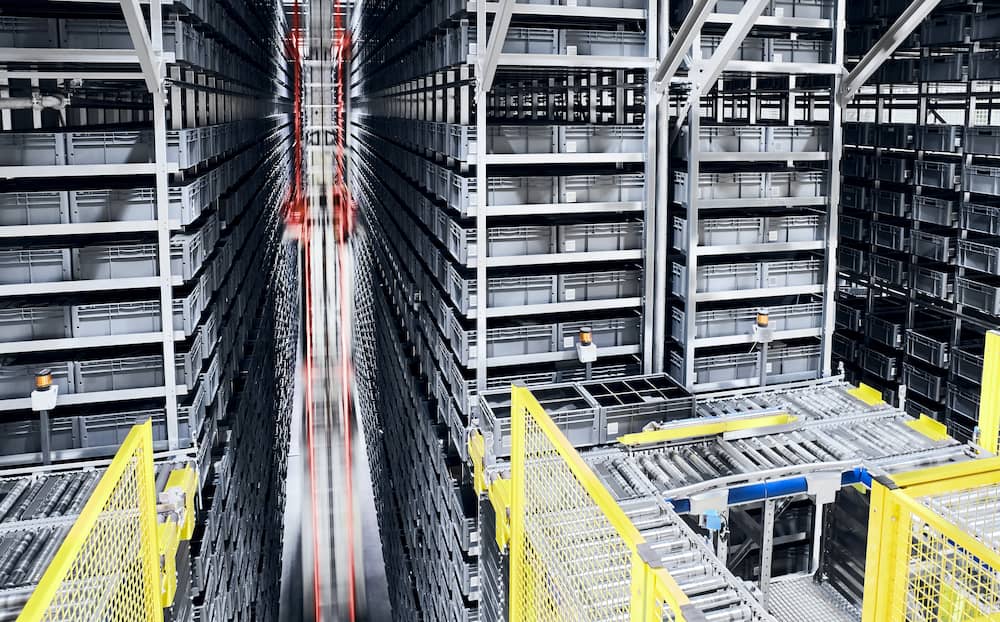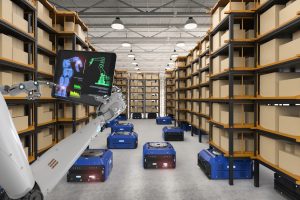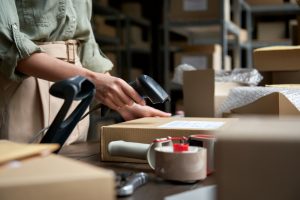As part of our Warehouse Automation series Matthew Hopkins, Director at BoxLogic, provides an overview of the traditional storage solutions such as Mini Load and Shuttle systems.
In this post, Matthew looks at the more established automated storage and retrieval solutions, outlining how they work, where they are used as well as the pros and cons of the technologies.

Introduction
Mini load and shuttle solutions store totes and/or cartons in high-bay racking, retrieving the required SKUs to operatives located workstations, often via a conveyor loop. This enables GTP (Goods-to-Person) picking, which achieves greater picking and putaway productivities by reducing the amount of walking an operative performs in a shift.

Solution Equipment
These solutions comprise several key items of equipment.
Equipment | Description |
|---|---|
Totes | Totes are plastic containers for storing products within the system. The totes can also be fitted with dividers to segregate multiple SKUs being stored within the same tote. Each tote is barcoded so that it can be traced throughout its handling journey. |
Racking | Racking supports the storage of totes in the system. Totes are stored on shelves, up to four loads deep, although the ability to do this depends on the SKU pareto and stock depth. The racking is laid out in aisles, according to the amount of storage required. |
Load-Handling Devices | The load-handling device moves totes between the racking and the P&D locations at the end of each aisle. The load-handling device in a mini-load system is a crane that moves up and down an aisle, accessing every level of racking.
Shuttle-based solutions use shuttles and lifts in the place of cranes. Robot-like ‘shuttles’ move up and down aisles, each typically accessing a single aisle and level within the racking, although other variants are available. Lifts take totes from every level down to the conveyor loop and workstations. |
Conveyor | Conveyor is generally used to move items between the P&D locations and the workstations where processing is performed on the stocked items. These can be relatively complex, as they are responsible for sequencing totes to pick stations. |
Workstations | Workstations are where human operatives, or sometimes robotic arms interact with the ASRS. It is at these locations where totes are presented to be filled with product, or picked from to fulfil customer orders.
The workstation is flexible in design and depends on how many orders are to be picked concurrently, how despatch cartons are supplied and taken away, whether pick-to-light technology is used and whether packing is conducted at the workstation. |
Control System | A control system is the brains and intelligence behind the solution, managing the order well, the flow of totes to the GTP workstations and accessibility of totes within the racking. It connects to the warehouse management system to receive and confirm customer orders as well as inventory holding. |
How do Shuttle Storage Solutions Work?
A typical tote-based mini-load or shuttle solution works as follows:
Decant
Goods are injected into the system via decant workstations, where a human operative empties replenishment cartons into the storage locations on the presented rack. The operative interacts with a terminal at the workstation to scan products, providing traceability to the control system of which items are placed within each tote, or section of a tote if dividers are used.
Putaway and Retrieval
Totes are put away into the racking using the conveyor. They are placed at a P&D location at the end of the aisle the WCS has determined there is an empty location in. Either a mini-load crane or a combination of the lift and shuttle complete the process of putting the tote into the racking. The process is reversed for a retrieval.
Picking
The picker will be presented with a tote at the workstation. A GTP pick station comprises a source tote (i.e. to pick from), one or more order containers (i.e. a tote or carton to pick into) and a computer terminal to support the picking process.
Completed order containers will be taken away to the packing, marshalling and despatch process.
Where Can Shuttle Solutions Be Used?
Traditional ASRS solutions are suitable for many industries and sectors where goods can be stored in totes. They are effective in both B2B and B2C environments where the order profiles can vary significantly. Although mini-loads and shuttles are distinct technologies, they can both be used for either case or unit picking. The correct application of the technology will depend on the level of throughput required, as they both offer a similar storage density.
Shuttles are more effective for operations where throughput is the more dominant requirement (versus storage). This allows shuttles on multiple levels within each aisle to feed high throughput lifts at the end of each aisle, typically working at a higher capacity than a single mini-load crane per aisle.
Mini loads tend to be more effective for operations with lower throughputs and where the facility supports longer aisles. They can be particularly useful for the bulk storage of carton loads and are often deployed in conjunction with shuttle systems; where the mini load stores and handles case quantities as well as replenishing a goods-to-person shuttle system that handles unit-level picking.
Pros and Cons of Shuttle Solutions
The traditional ASRS solutions of Shuttles and Mini Loads can operate at heights of up to 40 metres, depending on manufacturer. They offer unmatched storage density compared to other solutions at heights of 12m and above, whilst also providing excellent accessibility with applications extending up to four totes deep.
Shuttles and Mini Loads can be used for multiple functions, whether it be case or unit picking or as a despatch buffer. They can handle totes and cartons, although substandard carton quality may require tray handling and a larger storage footprint. When combined with goods-to-person systems, they offer some of the highest throughput solutions on the market.
Traditional ASRS solutions are not without their disadvantages though, requiring significant capital outlays and often greater operational costs with the requirement for onsite service and maintenance teams. The payback period is often longer, owing to the longer design and installation lead times (18-24 months).
Although solutions can expand as business volumes can grow, it is generally accepted that they are not as flexible as robotics solutions where the storage and throughput elements of the capital outlay can be relatively easily detached. Any expansion in throughput capacity typically has to be matched by an increase in storage capacity, and vice versa. Two-dimensional shuttle solutions do add flexibility, where shuttles can either move between aisles or move between levels to break the link between storage and throughput but can often come at a cost.
Comparable Technologies
Shuttle solutions work well in facilities that are 12 metres or higher where longer aisles are available, and a high throughput is required. However, other solutions are available in buildings at or below the 12-metre mark. Cube storage solutions (e.g. AutoStore), tote based AMR solutions (e.g. Exotec or AMR CTUs) are comparable at these heights, particularly when throughput isn’t the key driver.
Mini loads are a great option for case pick operations, where the throughput and building requirements allow. AMR Carton Transfer Units could also perform this task for operations with lower throughputs and more restricted buildings (e.g. clear height, floor strength, aisle lengths).
Summary
BoxLogic have a wealth of experience in warehouse design projects for a variety of cross-sector clients. From identifying suitable types of automation, analysing expected benefits and ROI timescales, through to shortlisting and suggesting vendors. Our independence means that we identify the most appropriate solution for you. If there is no case for automation, we will recommend a manual solution and help you design it.
BoxLogic is well positioned to assist you with your next Warehouse Automation project. Contact us to discuss your project today.



